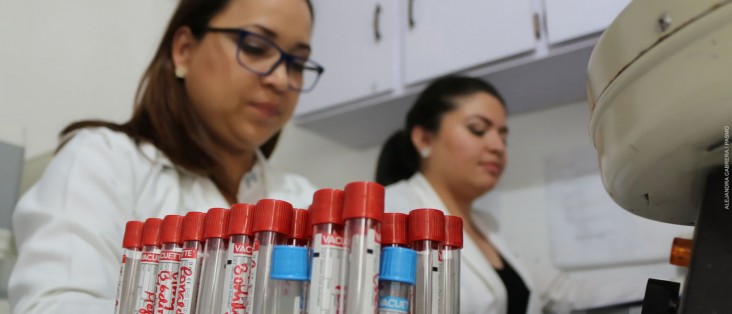Containing the HIV epidemic in Central America protects all populations and allows infected people to live longer with a better quality of life.
Through its Central America Regional HIV AIDS Program, USAID/Guatemala serves as a hub and implements the President’s Emergency Plan for HIV/AIDS Relief (PEPFAR) throughout the region in: El Salvador, Guatemala, Honduras, Nicaragua and Panama.
The USAID Central America Regional HIV/AIDS Program works with multiple stakeholders to support an integrated response that prioritizes financial sustainability, local capacity of government ministries and civil society, and institutionalization of processes and policies that guarantee quality HIV services, free from judgement or discrimination.
Increasing Effectiveness of Comprehensive Prevention, Care, and Treatment Services
USAID implements interventions to increase access to quality HIV services in order to achieve the global 95-95-95 targets (95 percent of people with HIV know their HIV diagnosis, 95 percent of diagnosed people receive Antiretroviral Therapy (ART), and 95 percent of people on ART reach viral load (VL) suppression).
USAID and PEPFAR have focused their efforts on improving direct service delivery and promoting accelerated actions to reach these targets. This includes encouraging local governments to increase their HIV investment and capacity strengthening of local partners for improved care and treatment.
Strengthening Health Systems
USAID supports the Ministries of Health and Social Security Institutes in Guatemala, El Salvador, Honduras, and Panama to coordinate national HIV response plans and develop national norms on HIV services including: standardized AART guidelines, improved knowledge and skills to deliver quality services, and support service delivery to key populations.
Additionally, USAID supports their supply chain strengthening to improve the availability of key health commodities, reducing and mitigating stockout risks. USAID increases the countries’ capacity to generate, compile, report and use logistics data to ensure adequate stock at healthcare sites and to identify inventory risks early.
USAID also provides technical assistance to improve management of health facilities through the Optimizing Performance and Quality approach. USAID works to ensure the best use of available resources, identifying modalities to ensure better price points through joint negotiation of antiretrovirals and other HIV-related commodities such as rapid test kits and post exposure prophylaxis kits.
Supporting Sustainability and Human Rights
In order to support sustainable HIV response, USAID conducts cost-efficiency and cost-benefit analyses to offer evidence in an effort to better invest national resources and control the epidemic. In addition, USAID supports the development of national policy frameworks and national sustainability strategies so that countries can map government resources and donor contributions with national need, ensuring that the country can continue a comprehensive HIV response.
USAID also supports the development of institutional strategies for the reduction of the stigma around HIV so that people can access the care that they need without discrimination. These interventions improve both the quality of HIV health services delivered and the quality of life for those living with HIV.



Comment
Make a general inquiry or suggest an improvement.